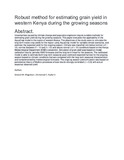| dc.contributor.author | Mugalavai, Edward M. | |
| dc.contributor.author | Kipkorir, Emmanuel C. | |
| dc.date.accessioned | 2021-06-03T14:01:25Z | |
| dc.date.available | 2021-06-03T14:01:25Z | |
| dc.date.issued | 2014-10-07 | |
| dc.identifier.uri | https://doi.org/10.2166/WCC.2014.237 | |
| dc.identifier.uri | https://iwaponline.com/jwcc/article-abstract/6/2/313/1604/Robust-method-for-estimating-grain-yield-in | |
| dc.identifier.uri | http://r-library.mmust.ac.ke/123456789/1573 | |
| dc.description.abstract | Uncertainties caused by climate change and population explosion require suitable methods for estimating grain yield during the growing seasons. This paper evaluates the applicability of the AquaCrop model in the region of western Kenya. The objectives of the study were to: simulate the long-term maize crop yields for the region using AquaCrop model for variable climate scenarios, and estimate the expected yield for the ongoing season. Climate was classified into below normal (<x̅ − 1∂), normal (between x̅ − 1∂ and x̅ + 1∂) and above normal (>x̅ + 1∂) conditions based on the Kenya Meteorological Department (KMD) convention. Simulation of grain yield was based on model calibration results, periodic KMD forecasts and the long-term mean for the seasons. The calibrated model is able to estimate both long-term seasonal grain yield and expected harvest for the ongoing season based on climatic conditions that are compared with the long-term seasonal characteristics and complemented by meteorological forecasts. The ongoing season yield simulation was based on persistence theory of Markov processes whose results strongly correlated (r = 0.9) with actual seasonal observed yield. | en_US |
| dc.language.iso | en | en_US |
| dc.publisher | Journal of Water and Climate Change | en_US |
| dc.subject | Robust, method, estimating, grain, yield, in growing, seasons | en_US |
| dc.title | Robust method for estimating grain yield in western Kenya during the growing seasons | en_US |
| dc.type | Article | en_US |

